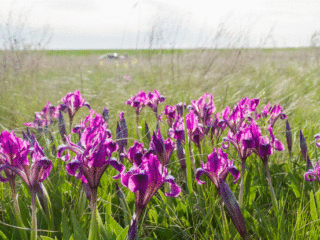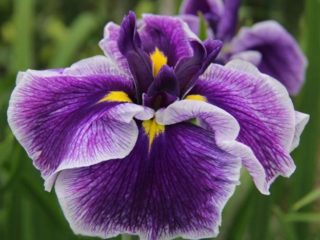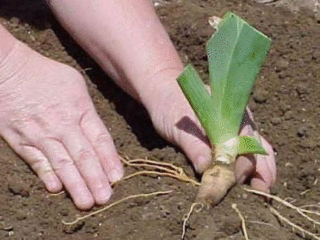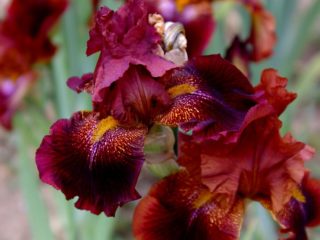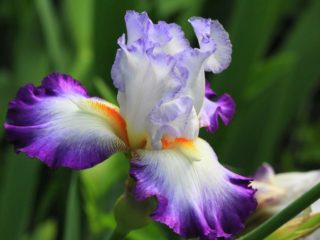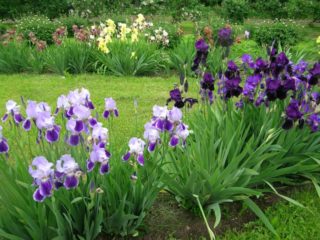Content
Diseases of irises can be caused by viruses and fungal pathogens. To correctly recognize the problem and cure the plant, you need to study the symptoms.
Signs and causes of iris disease
The iris is a beautiful flower that enters its decorative period in early summer. Healthy perennials delight the eye with colorful buds and bright green foliage. But sometimes the iris is affected by fungi and harmful insects. In such cases, the following symptoms appear:
- yellowing of leaves and stems;
- rotting of aboveground and underground parts of the plant;
- faded and weak flowering;
- brown and dark spots on leaves and petals.
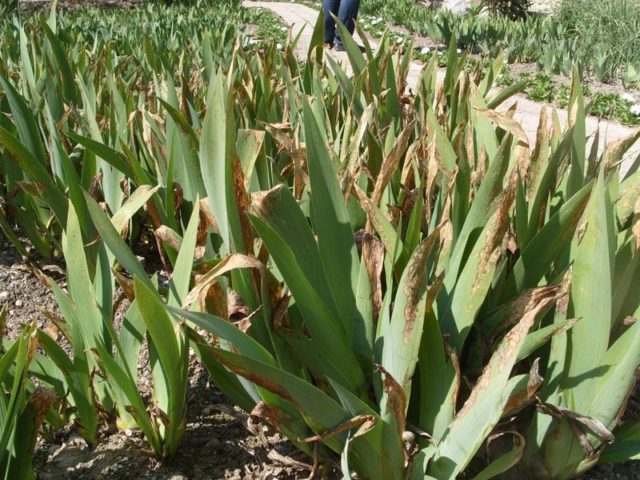
Symptoms of iris diseases are very similar to each other
There are quite a lot of diseases and pests of perennials. But they most often develop for the same reasons, namely:
- due to the presence of fungal spores or insect larvae already on the planting material;
- due to improper care, for example, due to severe drying out or waterlogging of the soil;
- due to proximity to infected plants.
Common diseases of irises and how to combat them
Most often, perennials on the site wither due to numerous fungi. Iris can also be affected by viral diseases, the latter being particularly dangerous.
Rust
Iris often suffers from rust, which is caused by the fungus Puccinia iridis. As the disease develops, the leaves of the perennial become covered with yellow-brown and brown spots-pustules. Rust causes the green parts of the iris to dry out and die, sometimes involving the stems.

Rust disease affects iris at temperatures above 12 ° C
To treat the disease, spraying with colloidal sulfur and Bordeaux mixture is used. Rust prevention consists of maintaining crop rotation and destroying plant debris in which fungal spores overwinter.
Mosaic
The Iris mosaic vims virus manifests itself as a net-like pattern on the leaves, sometimes the green parts of the perennial are covered with yellow stripes. Under the influence of the disease, the iris slows down its growth, begins to produce too short peduncles, faded or unnaturally variegated buds.
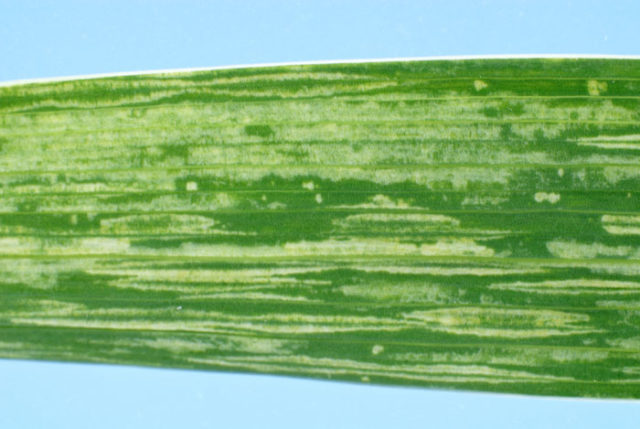
With mosaic disease, iris leaves become covered with yellow streaks
The mosaic virus is dangerous because it cannot be treated; the perennial is simply destroyed. You need to fight the disease preventively - buy material only in trusted stores, disinfect iris bulbs, seeds and rhizomes before planting.
Wet rot (bacteriosis)
Wet root rot is caused by the bacteria Pseudomonas iridis or Erwinia aroidea. Bacteriosis leads to the fact that the underground part of the iris rots, and the rhizome is destroyed from the inside, turning into a soft white mass. During the development of the disease, the perennial leaves turn brown, dry from the tips and easily fall out of the rosette.
In case of bacteriosis, the affected iris must be dug out of the ground and the rotten part of the rhizome must be cut off with a sterile knife. Then you can try to plant the perennial in a new place; if the underground part has not yet completely collapsed, it is still able to recover.
The disease most often develops when there is waterlogging and a lack of calcium and phosphorus. Therefore, for prevention, it is important to feed the iris in a timely manner, not to overwater it and regularly loosen the soil.
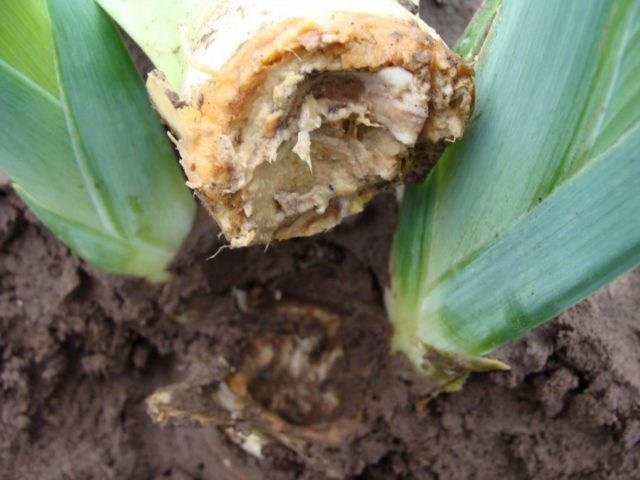
With bacteriosis, the iris begins to emit an unpleasant odor
Dry rot (fusarium)
The fungus Fusarium oxysporum also causes the roots to rot. The disease affects the feeding vessels, disrupts the vital processes of the perennial, causing the iris to turn yellow and dry out. Rotten areas and a gray-white coating first appear on the lower part of the rhizome, and then the underground part dries out entirely.
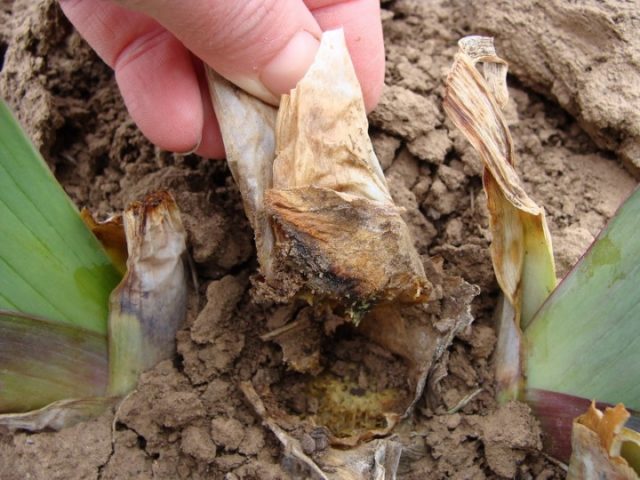
With dry rot, the iris rhizome simply crumbles
The disease most often develops against the background of excess nitrogen in the soil; spores awaken at temperatures above 12 °C in the spring. At the first signs of fusarium, you can spill the soil with a solution of copper sulfate. If this does not help, then the diseased iris is eliminated.
Gray rot
The disease is caused by the fungus Botrytis cinerea and usually develops during the flowering period in rainy weather.Against the background of the disease, the stems and buds of the iris turn pale, then turn brown and become covered with a light grayish coating.
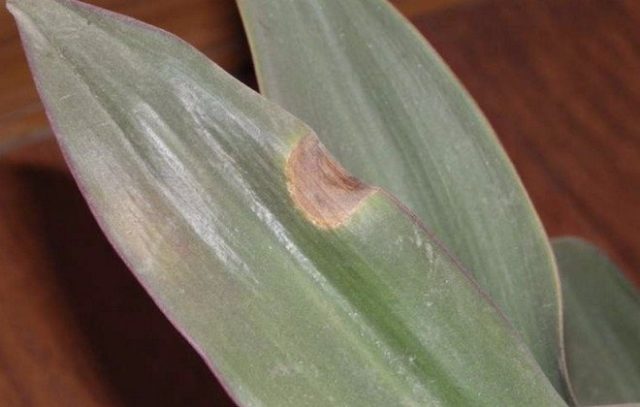
Gray rot disease affects leaves and develops at high humidity.
In the early stages of the disease, treatment is carried out with the drugs Topsin-M, Kuproskat and Oksikhom; copper solutions help well against gray rot. For prevention purposes, you need to monitor the soil moisture under the iris and observe moderation when fertilizing with nitrogen.
Botrytis
Botrytis disease develops under the influence of the fungi Botrytis convoluta and Sclerotium rolfsii. It usually occurs in conditions of high humidity and affects perennials in early spring. The roots become covered with dry rot, and sometimes mold can be seen at the bases of the leaves. The growth of the iris slows down, and by summer the green parts simply die off.
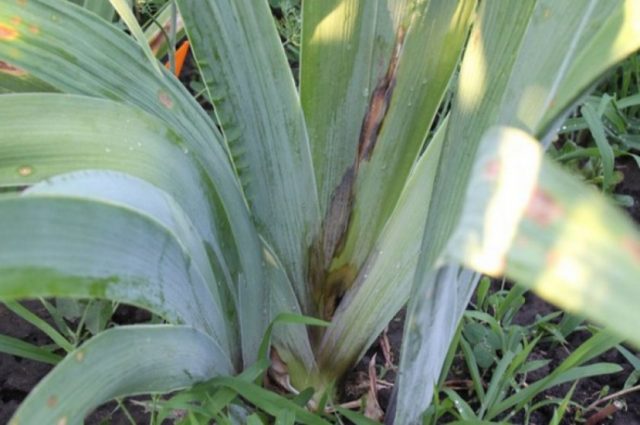
Botrytis disease affects the lower parts of iris leaves.
The fight against the disease is carried out by spraying with Bordeaux mixture and Topaz - in early spring and then twice more until the end of flowering. If the measures do not help, then the irises are dug up and destroyed, and the soil is spilled with formaldehyde.
Heterosporiasis
Heterosporium disease is caused by the fungi Heterosporium iridis and Mycosphaerella macrospora. In mid-summer, grayish-brown spots with a yellow border appear on the leaves of the iris. The perennial begins to dry out and may die completely, especially if the fungus attacks it at the height of the growing season.
The fight against heterosporiosis consists of removing all diseased leaves and spraying the plant with solutions of zinc and copper 3-4 times per season. To avoid disease, it is recommended to clear the flowerbed of debris in a timely manner and not to overfeed the iris with phosphorus and potassium.
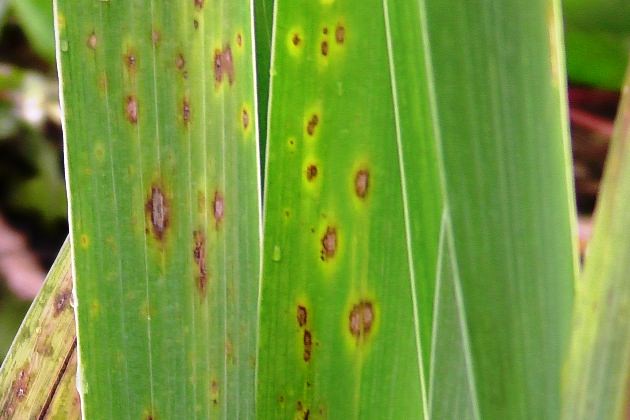
Heterosporia blight affects iris first on older leaves.
Ascochyta blight (leaf spot)
The disease develops under the influence of fungi from the genus Ascochyta; brown areas appear on iris leaves - first at the edges, and then closer to the center of the plates. The greenery of the perennial dries out and falls off, and if you dig it out of the ground, dark spots can be seen on the rhizome.
At the first symptoms of the disease, Bordeaux mixture has a good effect - spraying is carried out three times at intervals of 2 weeks.
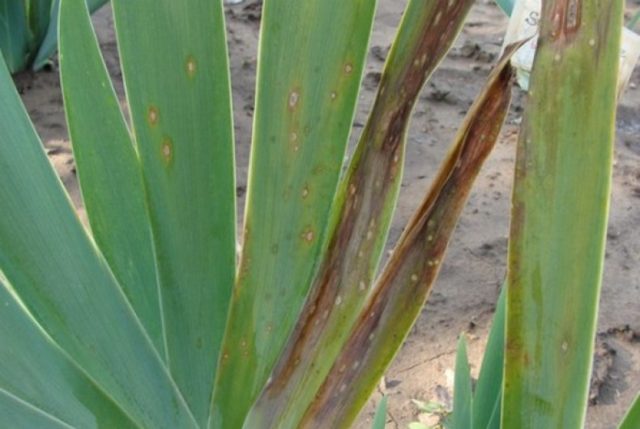
With ascochyta blight, iris leaves begin to darken at the edges.
Ascochyta blight most often develops on iris in conditions of high humidity and swampy soil.
Alternaria blight
A fungus from the genus Alternaria affects iris from mid-spring to late summer. Against the background of the disease, the edges of the leaf blades begin to dry out, then all the green parts become covered with a black coating, turn yellow profusely and crumble.
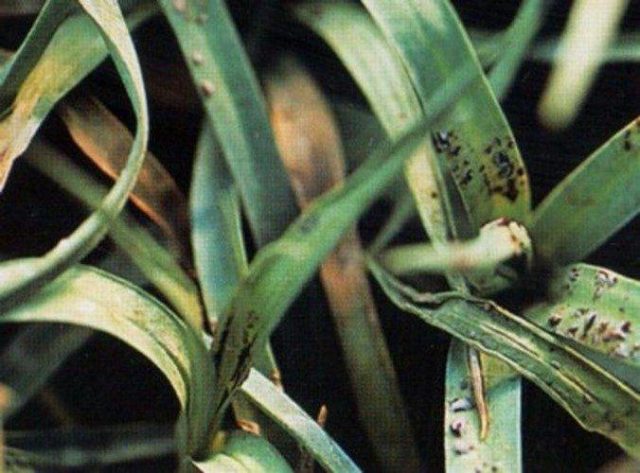
Black spots on the iris are characteristic of Alternaria
To prevent Alternaria, Bordeaux mixture is used; spraying is carried out before and after flowering. If the iris is already affected by the disease, then it is better to dig it up and burn it, since the spores quickly spread to other plants.
Pests of irises and measures to combat them
In addition to viruses and fungi, pests pose a great danger to perennials. Some of them are easy to notice on the leaves, others affect the root system and can quickly destroy the iris.
Onion mite
A small round insect with a yellowish body, the size does not exceed 1 mm and feeds on iris bulbs. It is active in early spring, and in summer it begins to reproduce and can produce new colonies every 20 days.
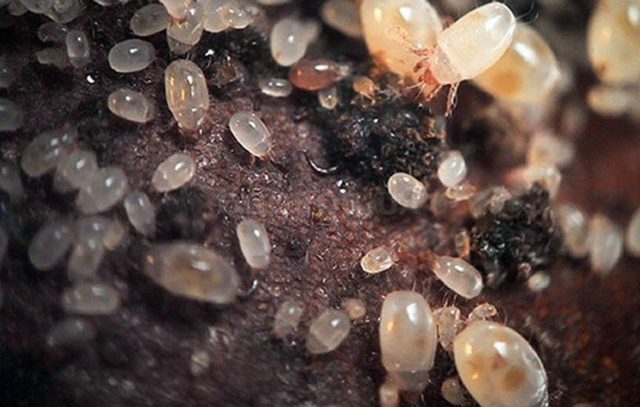
The iris onion mite goes unnoticed for a long time, so it is better to fight it preventively.
When infected with a mite, the scales of the iris bulbs dry out and wrinkle, and the perennial stops growing. A weakened plant is often affected by secondary fungal diseases. Pest control is carried out with systemic insecticides Actellik and Skor, but it is better to soak the material in Anti-Mite solution or sprinkle it generously with chalk before planting.
Thrips
A small insect, slightly more than 1.5 mm in length, settles on iris leaves, or more precisely, in rosettes at their very base. Thrips feed on the juices of the perennial, causing it to turn brown, dry out and become deformed. An infected iris does not always die, but blooms poorly or does not bear buds at all.
To get rid of the insect, you need to spray the plant with Karbofos solution twice with an interval of a week. Among the folk remedies, tobacco infusion works well.

In hot, dry weather, thrips produce up to 9 new generations per season
Onion nematode
The pest is a small white worm up to 1.5 mm long and reproduces in iris bulbs in moist soil. Under the influence of the nematode, the perennial begins to grow poorly, its stems swell, and the underground part cracks and becomes loose. A distinct unpleasant odor begins to emanate from it.
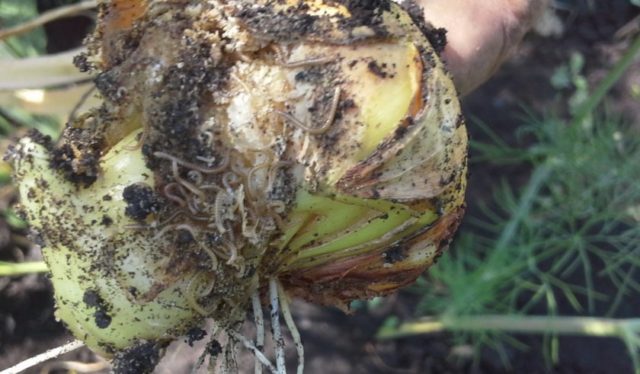
It is very difficult to cure onion nematode on iris - the pest manages to destroy the tuber
The nematode is difficult to control, it is extremely hardy and usually does not respond to treatment. Therefore, affected irises are destroyed and focused on prevention - they disinfect the bulbs before planting, monitor the soil moisture and loosen the flowerbed from time to time.
bean aphid
The insect looks like a small black-green or brown beetle that lives on the green parts of the iris.The pest has been active since mid-spring; under its influence, the shoots of the perennial are deformed, and the leaf blades turn pale and curl. If you do not fight aphids, then in the fall they will lay eggs at the roots, and in the spring the iris is attacked by a new generation of insects.
You can get rid of aphids using the drugs Iskra, Karate and Komandor; spraying is carried out 3-4 times per season. For prevention, you need to pay attention to weeding and loosening, and also feed the iris with potassium and phosphorus.
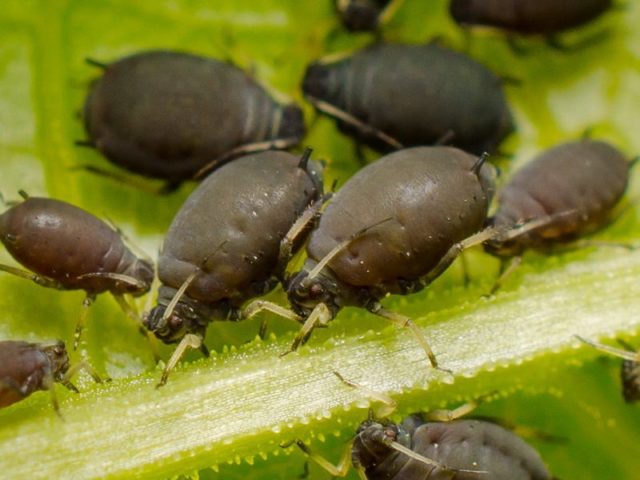
In hot weather, bean aphids can produce up to 10 generations per summer
Iris fly
A black-gray fly with golden spots on its body feeds on iris buds in late spring, and then lays eggs, from which voracious larvae emerge. The pest causes severe damage to flowering and plant health. Fly control is carried out using Aktara and Actellik three times a season.
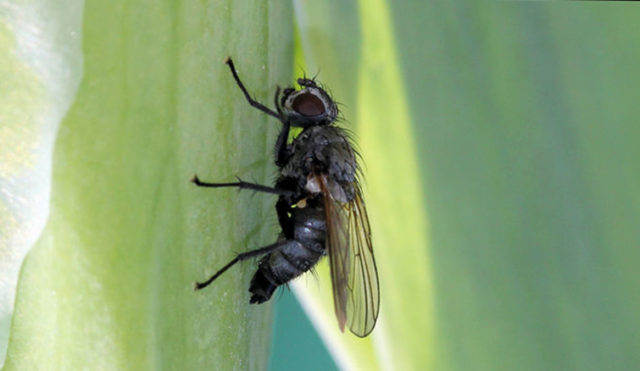
The iris fly and its larvae can completely destroy iris during the summer.
Folk remedies help against iris flies - tobacco dust, soap solution, ash.
Wireworms
Black or striped beetles lay their larvae in iris beds. Hatched pests feed on rhizomes and gnaw out long passages in them; fungal infections often develop against the background of mechanical damage. The affected perennial blooms worse and grows more slowly, and if seriously infected, it dies.
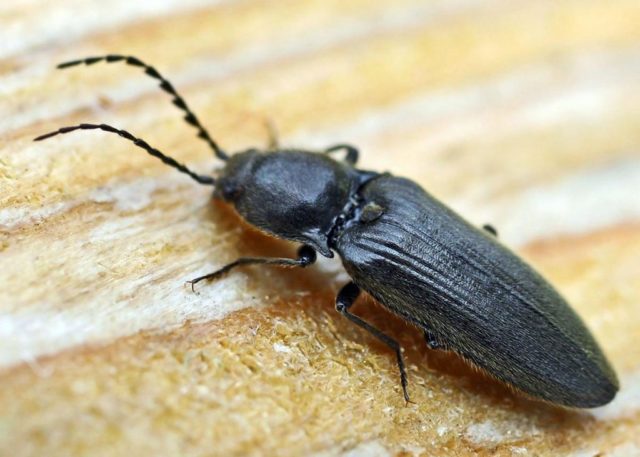
Wire beetle gnaws iris rhizomes
The fight against wireworms is carried out with the insecticides Decis and Aktara, as well as a decoction of red hot pepper.
Bronze beetle
Large greenish beetles with a metallic tint are active from late May until autumn. They can even be useful in the garden because they help pollinate. However, beetles feed on, among other things, the roots and buds of plants, so they pose a danger to the iris. You can notice their presence by the eaten flowers.
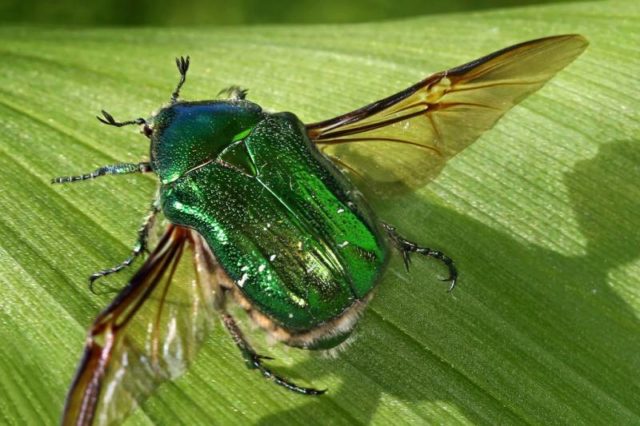
The generally beneficial bronze leaf is harmful to iris because it feeds on their leaves and flowers.
To get rid of the bronze beetle using the drug Kinmiks, you need to spray the flower bed with irises several times during the summer. A solution of wood ash has a preventive effect.
Medvedki
A large garden pest, it is an insect up to 5 cm in length with movable jaws and strong front claws. The mole cricket lives in the soil and digs deep passages in it, damaging the rhizomes and bulbs of the iris.
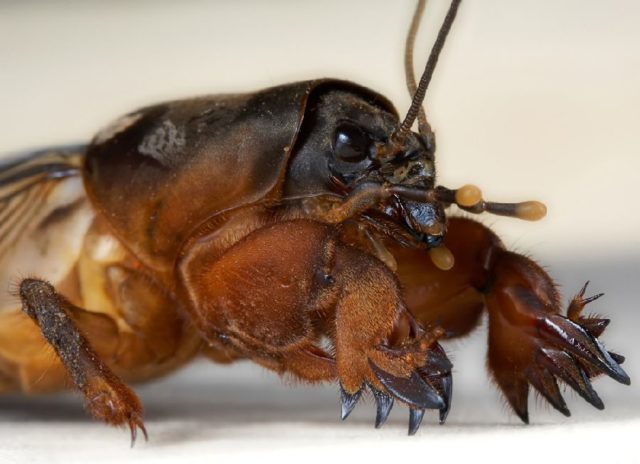
The mole cricket is difficult to destroy with insecticides; usually it is only driven to the surface of the earth and collected by hand
It is not easy to control the pest, so even at the planting stage, insecticides are poured into the holes for perennials. If the beetle does appear on the site, you can spill the soil with an infusion of chicken manure or generously treat the iris with Karbofos.
Scoops
At the beginning of spring, dangerous caterpillars of the iris or winter cutworm often appear in flower beds with irises. Pests eat the stems of perennials at the very base, as a result of which the flower stalks weaken, die, or break under gusts of wind. Also, caterpillars can eat rhizomes and bulbs, this will harm the iris in itself and provoke the development of fungal diseases.
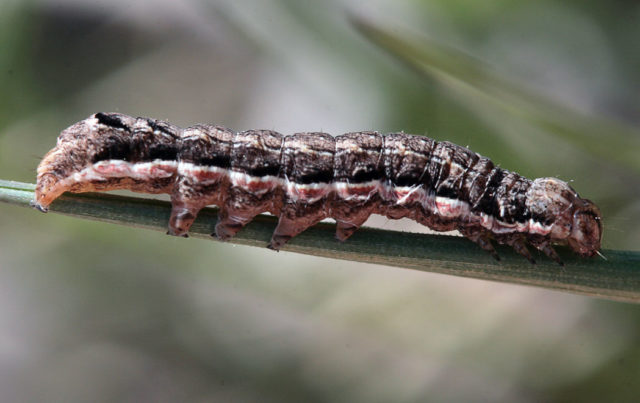
Cutworm caterpillars gnaw at iris stems, causing them to simply break.
You can get rid of the scoop by spraying with Karbofos.It is best to carry them out prophylactically, at the very beginning of spring and again a week later.
Prevention measures
Not all iris diseases are treatable, so it is easier to prevent their development. When caring for a flowerbed you must:
- control the humidity level - flowers should not be flooded;
- apply fertilizers moderately; if there is an excess of nitrogen, phosphorus or calcium, the neutrality of the soil is disturbed, and fungi begin to multiply more actively in it;
- regularly loosen the soil and remove weeds;
- remove faded shoots in a timely manner;
- carry out preventive treatment of iris in the spring against diseases and pests;
- disinfect planting material at the preparation stage - soaking in potassium permanganate or fungicidal agents significantly increases plant endurance.
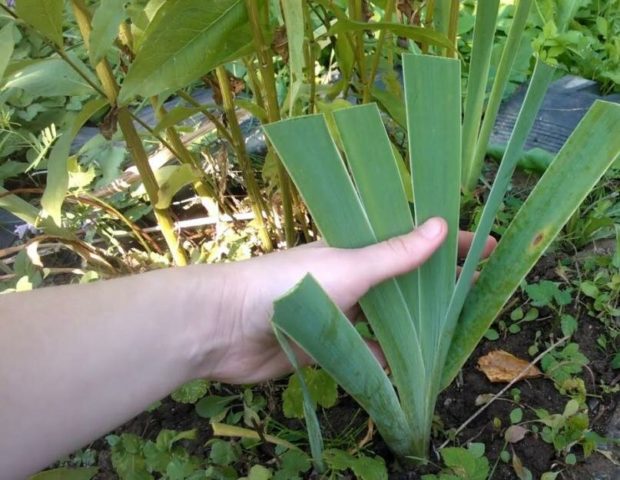
Autumn treatment of iris against diseases should be carried out after pruning.
In the fall, a flower bed with irises must be carefully dug up so that fungal spores and pests cannot survive the winter in the top layer of soil. Plant debris from the site is completely removed and burned; before the onset of cold weather, another treatment with fungicides is carried out.
Conclusion
Iris diseases appear most often when care rules are violated. As part of treatment, it is important not only to treat perennials, but also to eliminate risk factors - adjust the frequency of watering and soil composition.

